Honolulu, Oahu, Hawaii (Offshore Waters)
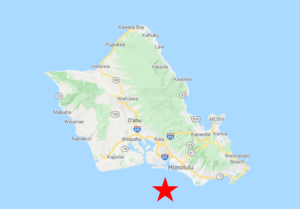
Honolulu’s waterfront provides direct access to productive tropical waters, and its harbors berth boat charters that can reach the deep ocean within a few minutes of leaving the dock. Such trips offer reasonable prospects of finding the rare Gray-backed Tern—which breeds among the much more abundant Sooty Terns and Brown Noddies on nearby Moku Manu—and are also likely to turn up various other pelagic seabirds. Regularly occurring species include two tropicbirds, five Pterodroma petrels, Bulwer’s Petrel, five shearwaters, and three boobies.
Orientation
Directions
Most offshore boat trips out of Honolulu depart from either Kewalo Basin Harbor or Ala Wai Boat Harbor, which are located about a mile apart, at opposite ends of Ala Moana Regional Park.
Ala Moana Park is Honolulu’s main waterfront property and public beach, about a mile south of the downtown area, accessed via Ala Moana Boulevard.
Kewalo Basin is at the western end of Ala Moana Park, directly beside Ala Moana Boulevard.
Ala Wai Boat Harbor is at the eastern end of the park, just across the Ala Wai (canal) in Waikiki, and is accessed via Holomoana Street—the first left turn after entering Waikiki on Ala Moana Boulevard.
Birdfinding
When planning an offshore trip from Honolulu, there are three basic directions to consider: southwest or east—then either north or southeast. Southwest is the shortest and calmest route to the outer slopes of the Hawaiian uplift. To the east is Ka Iwi Channel, the often-rough passage between Oahu and Molokai. Turning north in the channel takes you to the windward side of Oahu. Continuing east-southeast takes you to Penguin Bank, which is a subsurface extension of Molokai that is approximately the same size as Molokai and the largest “shoal” (<60 m deep) in the Hawaiian Islands.

The Gray-backed Tern is uncommon but regular in Honolulu’s offshore waters from around March to October. © Cameron Rutt
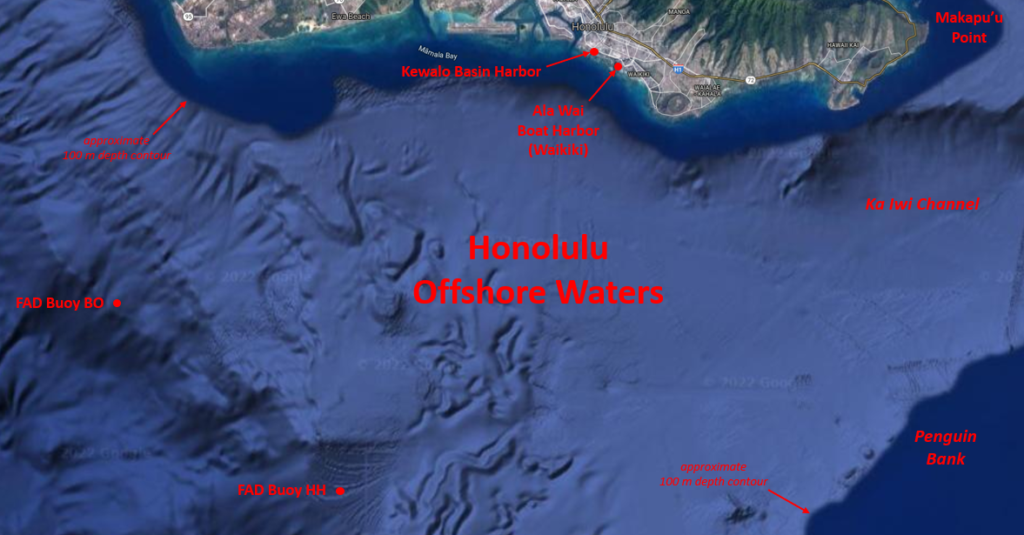
Southwest is the default option because it is on the leeward side of Oahu and therefore usually calmer than the other options. The usual approach is a triangular route: from the port to two offshore buoys—named BO and HH—then back to port. The buoys mark fish aggregating devices (“FADs”), structural materials that float at or near the surface and attract fish of various sizes. They make natural waypoints for an offshore trip and sometimes either the buoy or the attracted fish will attract the attention of birds.
The two FAD buoys are:
BO: 16.4 nautical miles west-southwest of Honolulu Harbor Light at 21° 9.0’ North, 158° 9.1’ West, in ~850 fathoms.
HH: 16.6 nautical miles south-southwest of Honolulu Harbor Light at 21° 2.1’ North, 158° 2.1’ West, in ~647 fathoms.
Species diversity in Hawaiian waters peaks during the transitional seasons, roughly March-April and September-October, when many pelagic seabird populations migrate between the Northern and Southern hemispheres. Many of the locally breeding seabirds also arrive in March and depart in October.
The following species are annual, or at least fairly regular, in the waters offshore from Wai’anae:
Yellow-billed Tropicbird: uncommon year-round
Red-tailed Tropicbird: uncommon March-September
Laysan Albatross: uncommon year-round
Black-footed Albatross: uncommon December-May
“Hawaiian Storm-Petrel”: rare April-November
Leach’s Storm-Petrel: uncommon March-April
Black-winged Petrel: uncommon March-November
Cook’s Petrel: rare June-November
Mottled Petrel: uncommon March-April and October
Juan Fernández Petrel: rare April-October
Hawaiian Petrel: uncommon April-November

Black-winged Petrel visits Hawaiian waters year-round, but is most common in September and October. © Hiroyuki & Shoko Tanoi
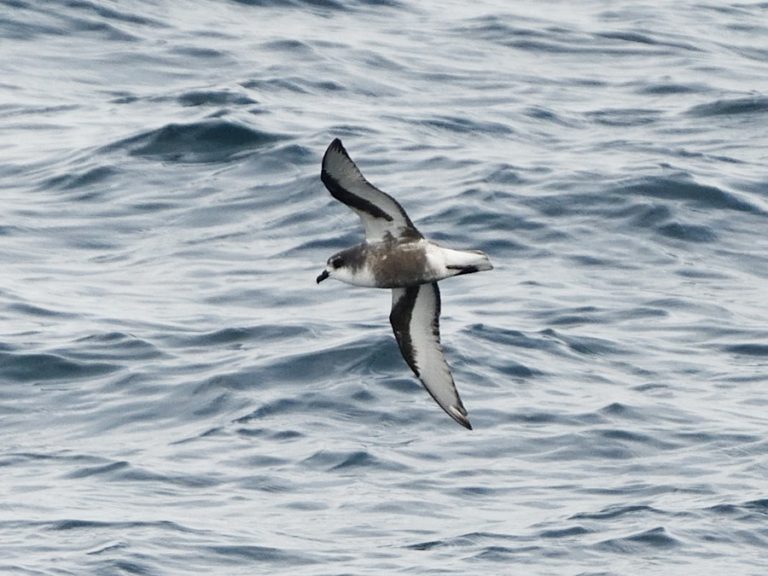
Mottled Petrel passes through Hawaiian waters northbound in March and April and southbound from late September to November. © Hiroyuki & Shoko Tanoi
Bulwer’s Petrel: fairly common April-October
Wedge-tailed Shearwater: very common March-November
Sooty Shearwater: fairly common March-April and September-October
Short-tailed Shearwater: rare September-December
Christmas Shearwater: rare March-October
Newell’s Shearwater: rare April-October
Great Frigatebird: common March-September
Red-footed Booby: common year-round
“Forster’s Booby”: common year-round
Masked Booby: fairly common March-October
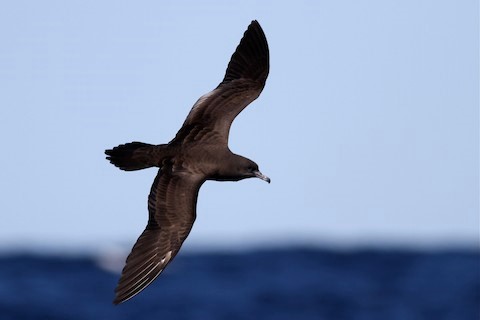
The Wedge-tailed Shearwater is the commonest tubenose in Oahu’s waters. © Chris Wiley

The Hawaiian endemic Newell’s Shearwater is a rare visitor to Oahu’s offshore waters from April to October. © Jacob Drucker
Red Phalarope: rare December-April
Long-tailed Jaeger: rare April-May
Parasitic Jaeger: rare April-May
Pomarine Jaeger: rare October-April
Common Fairy-Tern: common year-round
Sooty Tern: common March-November
Gray-backed Tern: uncommon March-October
Brown Noddy: fairly common March-November
“Hawaiian Noddy”: uncommon year-round
If the weather and seas are calm enough, a trip around Makapu’u Point to the windward side of Oahu may offer additional possibilities, such as Stejneger’s Petrel and Short-tailed Shearwater.
Oahu Nature Tours (natureguide@oahunaturetours.com, 1-808-551-0258) advertises five-hour offshore trips for up to four people, departing from Waikiki at 7:00 and returning at noon. These trips are not regularly scheduled—they require at least three customers (or the equivalent payment, of course), to charter the boat.
The other standard alternative is to go on a fishing charter. These trips are generally likely to visit productive offshore waters, and thus may create opportunities to see pelagic birds, but they are hit-or-miss. Most fishing charter captains have game-plans that combine a few proven approaches for certain fishes in that area at that time of year, and they know where the fish have been biting recently. With fuel and time-at-sea being precious, it is usually difficult to persuade a fishing charter captain to deviate from that day’s chosen game-plan.
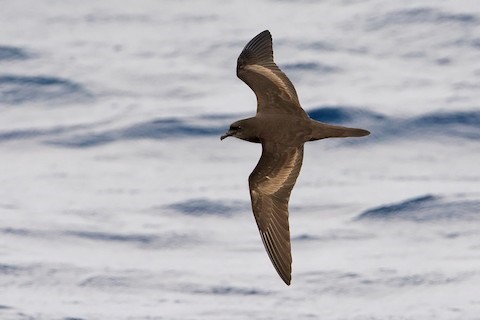
Bulwer’s Petrel is fairly common in Honolulu’s offshore waters during its breeding season from April to October. © Miguel Rouco
Most Honolulu charter fishing boats leave from Kewalo Basin. Sportfish Hawaii (1-877-388-1376, 1-808-295-8355) has several boats with different capacity and pricing options.
Services
Accommodations
Waikiki has a wide array of lodgings.
Budget:
The Breakers, 1-808-923-3181 (middle)
The Equus, 1-808-949-0061 (west end)
Kai Aloha Apartment Hotel, 1-808-923-6723 (middle)
Patrick Winston’s Waikiki Condos, 1-808-924-3332 (middle)
Royal Grove Hotel, 1-808-923-7691 (east end)
Mid-Range:
Aqua Bamboo Waikiki, 1-808-922-7777 (east end)
Aqua Oasis, 1-808-923-2300 (middle)
Coconut Waikiki, 1-808-923-8828 (middle)
DoubleTree Alana Hotel Waikiki, 1-808-941-7275 (west end)
Holiday Inn Waikiki Beachcomber, 1-808-922-4646 (middle)
Hotel Renew, 1-808-687-7700 (east end)
New Otani Kaimana Beach Hotel, 1-808-923-1555 (east end)
Ramada Plaza Waikiki, 1-808-955-1111 (west end)
Surfjack Hotel & Swim Club, 1-808-923-8882 (middle)
Expensive:
Halekulani, 1-808-923-2311 (middle)
Hilton Hawaiian Village Beach Resort & Spa, 1-808-949-4321 (west end, the largest hotel in Waikiki)
Royal Hawaiian, 1-808-923-7311 (middle)
Notes
When to Visit
Maximum diversity on pelagic trips in Hawaiian waters is generally expected in March, April, September, and October.
Hazards & Hassles
As with any other offshore boatride, visitors should prepare for a wide range of conditions by bringing: multiple layers of clothing (including an outer layer suitable for rain or seaspray), soft-soled shoes, sunscreen, sunglasses, and their favored seasickness prophylaxis.
Links